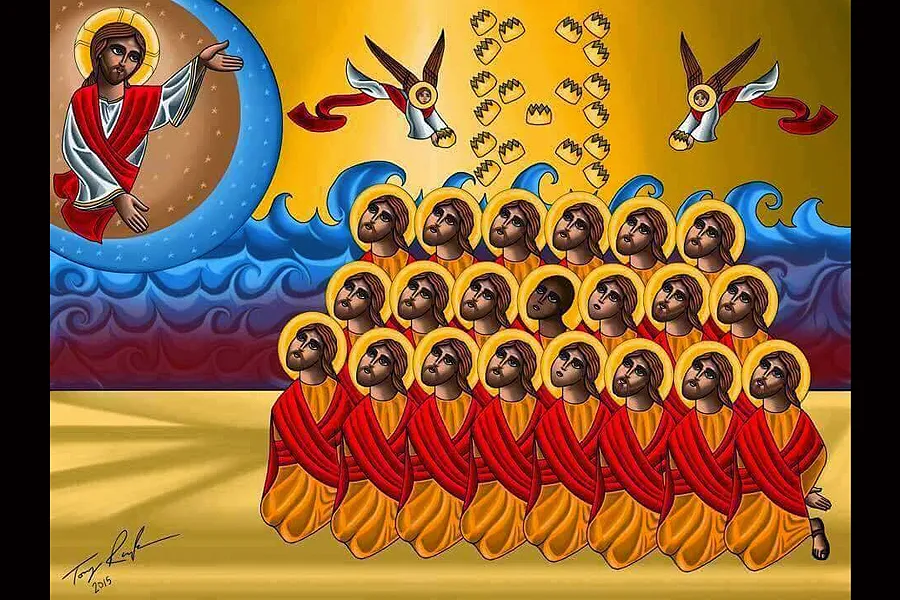 Memorial tree in Mayfouk, Lebanon, in remembrance of Christians killed in the Lebanese civil war. / Credit: Ambassador Alberto Fernández/EWTN News
Memorial tree in Mayfouk, Lebanon, in remembrance of Christians killed in the Lebanese civil war. / Credit: Ambassador Alberto Fernández/EWTN News
Washington D.C., Nov 20, 2024 / 10:35 am (CNA).
Nov. 20 marks Red Wednesday, a growing effort to show solidarity with the suffering Church.
Started in 2016 by the papal foundation Aid to the Church in Need (ACN), this year more than 300 Red Wednesday events will be held in 20 countries, including the United Kingdom, the United States, Canada, Australia, France, Spain, Portugal, Belgium, Germany, Italy, Slovakia, Austria, Ireland, Malta, the Philippines, Mexico, Chile, and Colombia.
In 2016, Pope Francis spoke about two types of persecution: “the explicit kind” — to which he related to the martyrs killed that Easter in Pakistan — “and the sort of persecution that is polite, disguised as culture, modernity, and progress, and which ends up taking away man’s freedom and even the right to conscientious objection.”
Red Wednesday in the Middle East
In the Middle East, there is no need to have a special day, week, or month to remember the persecution of the Church. While Red Wednesday is becoming better known there, it is not a tradition yet. But the issue is palpable on a daily basis, touching Middle Eastern Catholics, Orthodox, and Protestants alike.
The persecution occurs in both countries that are bitter adversaries of the West and in countries allied with the West, states at peace and those experiencing war.
With the commemoration of Red Wednesday approaching its first decade, here are some key milestones in the Red Wednesdays of the Church in the Middle East over the past 10 years.
2014
The year marked the destruction of the ancient Christian community of Mosul in Iraq as the entire population was expelled from the city with only the clothes on their backs, while items such as cellphones and baby strollers were seized by Islamic State gunmen. Months later, ISIS overran many of the Christian villages on the nearby Nineveh Plains, destroying, looting, and vandalizing. Three years later ISIS was defeated, but Christian communities today are dispersed and survivors struggle to find safety and a secure future.

2015
Twenty-one Christians were beheaded publicly on a beach in Sirte by the Islamic State. The 21 are the martyrs of Libya; 20 of them were Coptic Christians. In 2023, Pope Francis added them to the Roman Martyrology, the Church’s formal list of officially recognized saints.

Also in 2015, forces belonging to the Islamic State in Syria overran several Assyrian villages on the Khabur River in that country’s northeast, taking 253 men, women, and children hostage. Most of the remaining Assyrian Christian population fled while ISIS blew up more than a dozen churches. Over the next two years ransom was paid to release most of the hostages alive. The community — direct descendants of survivors of the Ottoman Genocide of Assyrians in 1915 — is devastated to this day. Most will never return home.
2020 (and ongoing)
Christian monuments in Turkey, including Aya Sofya — for 1,000 years the largest church in the world — were turned from museums into mosques by the Islamist government of President Recep Tayyip Erdoğan. Anatolia’s precious Christian architectural and historic heritage is crumbling.

2023
After enduring a yearlong punishing siege and malnutrition, the entire Armenian Christian population — more than 100,000 people — in the Nagorno-Karabakh region inside Azerbaijan is expelled. Today they are stateless and reduced to poverty in neighboring Armenia, which is itself threatened by more powerful neighbors.
Ongoing in Iran
Christians in Iran, many of them converts worshipping in underground “house churches,” face persecution and long jail sentences at the hands of Iranian authorities. Hundreds are arrested and detained yearly.
Christians are also targeted as vulnerable, marginalized minorities in situations that affect to a greater or lesser extent their non-Christian neighbors.
Ongoing in Iraq
In Iraq, Christians and other non-Muslims are targeted by criminal networks having murky ties to powerful militias and government authorities. These networks steal Christian property — houses and land — and seek to monopolize ostensibly Christian political representation for their own purposes.
Ongoing in Lebanon
In Lebanon, Christians not only face cycles of targeted intimidation — both virtual and physical — at the hands of the powerful Hezbollah militia and its allies, but many have been targeted for assassination over the past 20 years, including Christian politicians, journalists, and activists as well as Elias Hasrouni in 2023 and Pascal Suleiman in 2024. War today touches both Christians and non-Christians in a battered and desperate country.
Ongoing in Egypt
In Egypt, the largest remaining Christian population in the region not only faces official discrimination by the state at different levels and in a variety of fields, but they are still the subject of extremist violence targeting their churches and their communities.
Ongoing in the Holy Land
Christians in the Holy Land are affected by the violence and insecurity that affect their Muslim and Jewish neighbors but are often singled out by extremists from both of those communities, caught, as it were, between two fires.
Despite such calamities, the Christians of the East endure, rooted in their land and faithful to their traditions, praying, as all do, that “in all things we may be defended by your protecting help.”
Original Source:
https://www.catholicnewsagency.com/news/260585/red-wednesday-in-the-land-of-the-martyrs